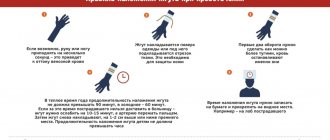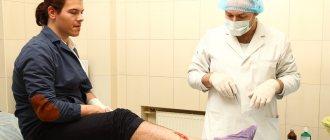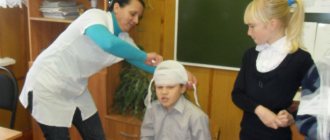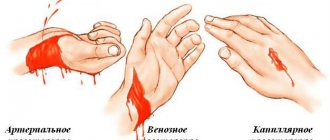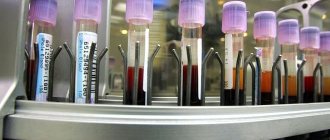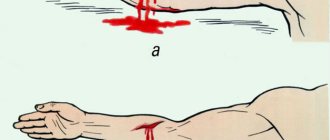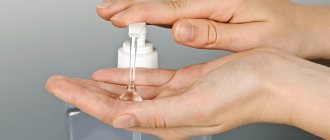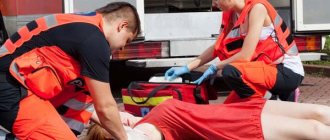Loss of blood is a very dangerous phenomenon that can lead to death in a short time. Without the timely provision of specialized care, the chances of survival with major blood loss are lost every minute. This necessitates the need to have basic first aid skills that can save a person. In this article we will pay attention to venous bleeding, its features, and first aid techniques.
Stopping venous bleeding is one of the most important first aid skills, as damage to large vessels can lead to massive blood loss and death in a matter of minutes.
Specifics and signs of venous bleeding
Specifics and signs of venous bleeding
Veins are a network of vessels that move blood from internal organs to the heart muscle.
Signs of bleeding that occurs due to mechanical damage to the veins are: - dark - brown color of blood (unsaturated with oxygen, unlike cases of arterial bleeding) - smooth, non-pulsating flow - pallor and lethargy of the injured person Venous bleeding can be determined by pressing on the vein near the bleeding wound - with venous bleeding, blood loss will be sharply reduced. Depending on the location of the wound, the nature of first aid varies somewhat, therefore, having identified the source of bleeding, it is necessary to quickly implement an algorithm for providing assistance. Basic rules for providing first aid step by step, ways to stop
Why is capillary bleeding dangerous for humans?
An important function of blood is to transport oxygen and nutrients. They are delivered to the tissues, and metabolic products and carbon dioxide are removed from there. With minor damage to the capillaries and shallow wounds there is no threat to health. However, with extensive capillary bleeding, this vital function is disrupted, resulting in possible oxygen deficiency. First of all, the heart muscle and nervous system suffer from oxygen starvation, which threatens life.
First aid for capillary bleeding is necessary not only in case of serious injuries, but also if blood comes from the nose, ear, gums, digestive tract, uterus and other organs.
The main distinguishing feature of capillary bleeding is the slow release of blood over the entire wound surface. There are two types of capillary bleeding: internal (the most dangerous of them are uterine, intestinal and gastric) and external.
Experts identify several causes of capillary bleeding, including traumatic, coagulopathic and pathological:
- Diseases of the blood coagulation system are hemophilia, thrombocytopenic purpura, von Willebrand disease;
- Traumatic injuries (abrasions, burns, cuts). According to the classification, they are divided into thermal, which arise from exposure to critically high temperatures, and mechanical, which occur in the event of various extreme situations (accidents, falls, fights);
- Vascular diseases in which damage to the skin and tissue occurs (tumors, purulent inflammation of the skin involving capillaries);
- General diseases (oncological processes, rheumatoid arthritis, multiple sclerosis, necrosis, atherosclerosis), which affect the vascular walls throughout the body. As a result, plasma and blood cells leak out and extensive internal capillary bleeding occurs;
- Hormonal dysfunctions.
Internal capillary bleeding over time can lead to the formation of interstitial and intra-articular hematomas. Such bleeding from parenchymal organs (liver, spleen, brain) if they are damaged poses a great danger.
Basic rules for providing first aid step by step, ways to stop
Generally accepted actions when venous bleeding is detected are as follows:
- The sections of the vein above and below the injury site must be clamped as close to the bone as possible. To clamp the vein, a tourniquet, thick fabric and similar improvised means are used; in the absence of means, clamping is done with the fingers.
- The wound must be covered with cotton wool or a piece of fabric - this will prevent air bubbles from entering the vein and prevent further development of air embolism.
- If possible, it is necessary to apply ice or any cold object to the wound site that helps slow down the flow of blood circulation.
- Calling an ambulance or any action to hospitalize the victim as quickly as possible. Specific algorithms for providing assistance
In addition to the general rules for providing assistance with venous bleeding, there are some specific rules that apply depending on the location of the vein damage. Damage to the distal segments located at a distance from the body poses less danger than bleeding from the proximal areas. Measures for bleeding from distal segments (hands and feet, forearm) are as follows: - Pressing the vein with your fingers, in the area below the wound - The damaged limb must be raised above the level of other limbs - The open wound must be clamped with a cotton swab dipped in hydrogen peroxide - If possible, it is necessary to apply a compressive fabric bandage. Measures to stop bleeding from the proximal area (thigh, shoulder): - The damaged area must be elevated - Application of a pressure bandage necessary to reduce the flow of bleeding - Mandatory application of a tourniquet - When visually stopping the bleeding, the tourniquet is removed, the wound is tamponed, and a pressure bandage is applied again.
A way to stop venous bleeding is to apply a tourniquet
A way to stop venous bleeding is to apply a tourniquet
Half the success of the fight against venous bleeding depends on the correct application of the tourniquet. Therefore, you should know how this measure of medical care is carried out.
- The tourniquet should be applied below the injury site, as close as possible to the wound itself.
- It is necessary to place a piece of bandage or fabric under the applied tourniquet to prevent damage to the skin.
- The tourniquet is applied by quickly wrapping the limb and tightening
- The exposure time of the tourniquet cannot exceed 1.5 hours, therefore, immediately after stopping the bleeding, the victim should be hospitalized as quickly as possible.
Bleeding in the veins of the neck
Long-term crush syndrome (Crush syndrome)
When a person gets caught in a rubble
- apply a tourniquet above the point of pressure and only then release
- released - tightly bandage the limb and remove the tourniquet
- plenty of warm drinks
- anti-shock measures and urgent hospitalization
This material is part of the School of First Aid course “Space of Safety”. We recommend signing up for classes at the school by calling +7 495 760—9092 or on the website https://www.allsafety.ru
Source: https://www.allsafety.ru/
Bleeding in the veins of the neck
Why is damage to the veins in the neck dangerous?
- Without professional skills, it is impossible to apply a bandage without causing suffocation in the victim;
- vessels in the neck area are large in diameter, their injuries cause profuse and rapid blood loss, so first aid must be provided as quickly as possible;
- Air can be sucked into the lumen of a large vessel, resulting in the formation of an air plug (embolism), which can cause death.
How to stop bleeding if your neck is injured:
- Lay the person down so as to provide easy access to the wound.
- If possible, apply a cotton or gauze cloth folded several times and soaked in antiseptic (hydrogen peroxide) to the wound.
- Press the area above and below the injury with three fingers (ring, middle and index) of both hands folded together.
You can consider that you have achieved results if the bleeding has stopped or greatly weakened, but the pulsation of deep vessels is felt under your fingers.
Nose bleed
Nose bleed
A strong flow of blood from the nose is stopped in this way:
- the victim must sit down so that blood can flow freely from the nose: tilting his head down slightly;
- to stop the bleeding, you need to clamp the damaged vessels by pressing on the wings of the nose on both sides for 5 minutes (if the cause is not a fracture);
- any cold object is applied to the bridge of the nose: a wet handkerchief, ice, snow;
- if the blood cannot be stopped within 15 minutes, turundas from a rolled-up bandage are inserted into both nostrils;
- It is strictly forbidden to throw back your head, suck in blood through your nose, or swallow it: vomiting may occur.
AGAIN POINT BY POINT
Sources
- Zideman DA., Singletary EM., Borra V., Cassan P., Cimpoesu CD., De Buck E., Djärv T., Handley AJ., Klaassen B., Meyran D., Oliver E., Poole K. European Resuscitation Council Guidelines 2021: First aid. // Resuscitation - 2021 - Vol161 - NNULL - p.270-290; PMID:33773828
- Gyedu A., Stewart B., Otupiri E., Donkor P., Mock C. First Aid Practices for Injured Children in Rural Ghana: A Cluster-Random Population-Based Survey. // Prehosp Disaster Med - 2021 - Vol36 - N1 - p.79-85; PMID:33491619
- Singletary EM., Zideman DA., Bendall JC., Berry DA., Borra V., Carlson JN., Cassan P., Chang WT., Charlton NP., Djärv T., Douma MJ., Epstein JL., Hood NA ., Markenson DS., Meyran D., Orkin A., Sakamoto T., Swain JM., Woodin JA., De Buck E., De Brier N., O D., Picard C., Goolsby C., Oliver E ., Klaassen B., Poole K., Aves T., Lin S., Handley AJ., Jensen J., Allan KS., Lee CC., De Buck E., De Brier N., O D., Picard C ., Goolsby C., Oliver E., Klaassen B., Poole K., Aves T., Lin S., Handley AJ., Jensen J., Allan KS., Lee CC. 2021 International Consensus on First Aid Science With Treatment Recommendations. // Resuscitation - 2021 - Vol156 - NNULL - p.A240-A282; PMID:33098920
- Singletary EM., Zideman DA., Bendall JC., Berry DC., Borra V., Carlson JN., Cassan P., Chang WT., Charlton NP., Djärv T., Douma MJ., Epstein JL., Hood NA ., Markenson DS., Meyran D., Orkin AM., Sakamoto T., Swain JM., Woodin JA., De Buck E., De Brier N., O D., Picard C., Goolsby C., Oliver E ., Klaassen B., Poole K., Aves T., Lin S., Handley AJ., Jensen J., Allan KS., Lee CC., Schmölzer GM., Morley PT., Nieuwlaat R., Lang E. 2021 International Consensus on First Aid Science With Treatment Recommendations. // Circulation - 2020 - Vol142 - N16_suppl_1 - p.S284-S334; PMID:33084394
- Chang KC., Huang YK., Chen YW., Chen MH., Tu AT., Chen YC. Venom Ophthalmia and Ocular Complications Caused by Snake Venom. // Toxins (Basel) - 2021 - Vol12 - N9 - p.; PMID:32911777
- Coughlin DJ., Boulter JH., Miller CA., Curry BP., Glaser J., Fernandez N., Bell RS., Schuette AJ. An Endovascular Surgery Experience in Far-Forward Military Healthcare-A Case Series. // Mil Med - 2021 - Vol185 - N11-12 - p.2183-2188; PMID:32812042
- Sumardino S., Widodo., Poddar. Analysis of pre hospital emergency management in case of head injury. // Enferm Clin - 2020 - Vol30 Suppl 5 - NNULL - p.228-233; PMID:32713577
- Goolsby C., Rojas LE., Rodzik RH., Gausche-Hill M., Neal MD., Levy MJ. High-School Students Can Stop the Bleed: A Randomized, Controlled Educational Trial. // Acad Pediatr - 2021 - Vol21 - N2 - p.321-328; PMID:32473216
- Menger R., Lin J., Cerpa M., Lenke LG. Epidural hematoma due to Gardner-Wells Tongs placement during pediatric spinal deformity surgery. // Spine Deform - 2021 - Vol8 - N5 - p.1139-1142; PMID:32314179
- Zhao YF., Zhao JY., Hu WZ., Ma K., Chao Y., Sun PJ., Fu XB., Zhang H. Synthetic poly(vinyl alcohol)-chitosan as a new type of highly efficient hemostatic sponge with blood -triggered swelling and high biocompatibility. // J Mater Chem B - 2021 - Vol7 - N11 - p.1855-1866; PMID:32255048
AGAIN POINT BY POINT
- It is necessary to find the location of the damage.
- Raise and secure the limb.
- There is no time to clean and disinfect the wound if there is heavy blood loss - it is important to stop it, so ask the victim to press the vein with his hand below the injury site or do it yourself.
- A pressure bandage is applied below the cut or puncture site and can be made from any dressing material that is at hand: a bandage, a piece of clean cotton fabric, a handkerchief.
- Before you start bandaging, you need to place a cloth folded several times below the cut site, this way, when applying a bandage, you will achieve the necessary pressure on the lumen of the damaged vessels to reduce bleeding.
- The bandage should be made several times around the limb, starting from a thinner place. A positive result of first aid for venous bleeding is if the bleeding has stopped and the pulse can be felt below the bandage. This means that you managed to reduce the lumen of the blood vessels, but did not disrupt the blood supply.
- The victim must be taken to the hospital within 2 hours (in winter this period is halved) since an incorrectly applied, too tight bandage can cause tissue necrosis.
When small venous vessels are damaged, spontaneous formation of a blood clot occurs, and the bleeding stops on its own or after applying a pressure bandage. The blood loss in this case is small and is usually not life threatening. However, only a doctor can give a general assessment of the victim’s condition.
In case of damage to medium and large veins (jugular, subclavian and femoral), a favorable prognosis depends on timely assistance. Blood loss in a short time (30 to 50 minutes) can be fatal. A serious complication is the filling of the bed with an air plug (the vein fills with air during inhalation, when negative pressure is formed in it), which can lead to death from embolism earlier than from blood loss.
When providing first aid successfully, you need to remember that it is possible to finally stop bleeding from damaged vessels only in a medical institution.
